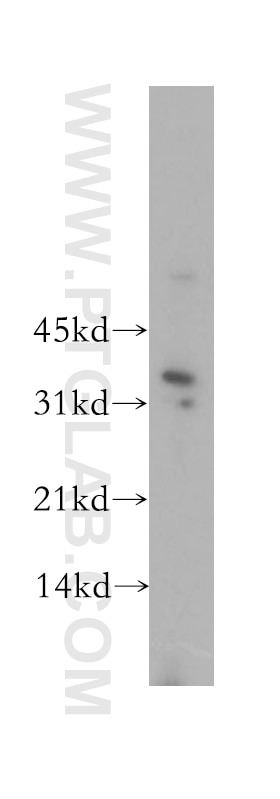Validation Data Gallery
Tested Applications
| Positive WB detected in | HepG2 cells, MCF-7 cells |
Recommended dilution
| Application | Dilution |
|---|---|
| Western Blot (WB) | WB : 1:500-1:1000 |
| It is recommended that this reagent should be titrated in each testing system to obtain optimal results. | |
| Sample-dependent, Check data in validation data gallery. | |
Product Information
12812-1-AP targets TSPAN12 in WB, ELISA applications and shows reactivity with human, mouse, rat samples.
| Tested Reactivity | human, mouse, rat |
| Host / Isotype | Rabbit / IgG |
| Class | Polyclonal |
| Type | Antibody |
| Immunogen | TSPAN12 fusion protein Ag3514 相同性解析による交差性が予測される生物種 |
| Full Name | tetraspanin 12 |
| Calculated molecular weight | 305 aa, 35 kDa |
| Observed molecular weight | 28 kDa |
| GenBank accession number | BC031265 |
| Gene Symbol | TSPAN12 |
| Gene ID (NCBI) | 23554 |
| RRID | AB_2208667 |
| Conjugate | Unconjugated |
| Form | Liquid |
| Purification Method | Antigen affinity purification |
| UNIPROT ID | O95859 |
| Storage Buffer | PBS with 0.02% sodium azide and 50% glycerol , pH 7.3 |
| Storage Conditions | Store at -20°C. Stable for one year after shipment. Aliquoting is unnecessary for -20oC storage. |
Background Information
TSPAN12 is a membrane protein of the tetraspanin superfamily, which are characterized by the presence of four conserved transmembrane regions. Tetraspanins have been involved in diverse processes such as cell activation and proliferation, adhesion and motility, differentiation, and cancer. TSPAN12 regulates retinal vascular development by promoting Norrin/beta-catenin signaling (PMID: 19837033 ). Mutations in TSPAN12 are a relatively frequent cause of familial exudative vitreoretinopathy (FEVR) (PMID: 20159111).
Protocols
| Product Specific Protocols | |
|---|---|
| WB protocol for TSPAN12 antibody 12812-1-AP | Download protocol |
| Standard Protocols | |
|---|---|
| Click here to view our Standard Protocols |

